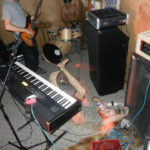Getting Involved in Regional Sustainable Development
I spent two days this fall with the University of Minnesota Extension’s Northeast Regional Sustainable Development Partnerships, which brings community leadership to the table with the research and educational resources of the University of Minnesota. I’m the last half of that sentence, I guess.
We met at the Environmental Protection Agency’s Great Lakes Toxicology and Ecology Division Laboratory, one of the last structures you pass as you exit Duluth headed up the North Shore. Its meeting rooms are magnificent, and I am hopeful that federal commitment to the EPA continues.
The RSDP met earlier in the semester at a farm in Aitkin, Clear Lake Gardens.
I learned a lot at this meeting, including the rich complexity of rural life — some of the farms in our region are the workhorses of agriculture, and some are gems of small but precious value. And I am really getting to know the engine behind RSDP in our region, David Abazs, who also runs a farm in Finland, Minnesota.
I also learned a story that I am carrying with me for a long time. A community in northeastern Minnesota once asked for help from the university to plan economic development. It had a population of fewer than 100 people, and it was mostly notable for being a place you drove through on your way to another place (on the state highway or on a snowmobile trail). How could the community grow?
The university suggested adding a restaurant and possibly a hotel and an event center near the trail. People passing through, it was argued, might no longer pass through, but instead stop. And as they stop and build connection to the community, they might become more intentional about stopping, staying, and planning events there.
The town thanked the university for its help and deposited the report and suggestions in the trash.
The town had no municipal water supply. It was located too far from the closest city with running water and sewer services for an extension, and so everyone, including the town hall, operated on well water and septic.
It is illegal in Minnesota to build a hospitality business on well water and septic unless you engage in prohibitively expensive and frequent testing of the water quality. (Basically, we shift guarantees of water quality from the city to the business.)
So none of the university’s recommendations could be enacted.
When asked, later, about how the community felt about these plans, some individuals simply noted that all they really wanted was a gas station, a place to buy milk when they ran out, without driving 15 miles each way. These larger visions of economic development were more than they wanted, and not what they could execute, anyway.
It’s time for change in the RSDP. This was the last meeting chaired, I think, by Allison Rian, of Aitkin (in the photo below). Allison showed herself to be passionate and kind as our leader.
We have a new leader, and we are looking for new blood. If you are looking for new ways to serve your community while being connected to the University, consider joining the various committees and other leadership roles in RSDP.
And, if you are not interested in that level of commitment to RSDP, consider submitting an Idea Brief — a 1-2 page document that explains a project that would benefit from university investment of time, expertise, student labor, and small amounts of money. Anyone can submit an idea brief — from a township to a nonprofit to a for-profit business (with an idea that has implications for the community).
I got involved in RSDP by submitting an Idea Brief. Maybe you can too.
(All photos by me.)
Recommended Links:
Leave a Comment
Only registered members can post a comment , Login / Register Here



















No Comments